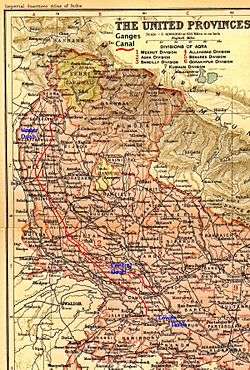Company rule in India
Company rule in India (sometimes, Company Raj,[2] "raj", lit. "rule" in Hindi[3]) was the rule or dominion of the British East India Company over parts of the Indian subcontinent. This is variously taken to have commenced in 1757, after the Battle of Plassey which saw the Company conquest of Mughal Bengal.[4] Later, the Company was granted the diwani, or the right to collect revenue, in Bengal and Bihar;[5] or in 1773, when the Company established a capital in Calcutta, appointed its first Governor-General, Warren Hastings, and became directly involved in governance.[6] By 1818, with the defeat of Marathas followed by the pensioning of the Peshwa and the annexation of his territories, British supremacy in India was complete.[7]
Company rule in India | |||||||||||||||||
|---|---|---|---|---|---|---|---|---|---|---|---|---|---|---|---|---|---|
| 1757–1858 | |||||||||||||||||
Motto: Auspicio Regis et Senatus Angliae "By command of the King and Parliament of England" | |||||||||||||||||
| Status | Joint-stock colony established by the East India Company and regulated by the British Parliament. | ||||||||||||||||
| Capital | Calcutta (1757–1858) | ||||||||||||||||
| Common languages | English (official) Hindustani, Tamil, Burmese, Bengali, many others | ||||||||||||||||
| Government | Corporatocracy | ||||||||||||||||
| Governor-General | |||||||||||||||||
• 1774–1785 (first) | Warren Hastings | ||||||||||||||||
• 1857–1858 (last) | Charles Canning | ||||||||||||||||
| History | |||||||||||||||||
| 23 June 1757 | |||||||||||||||||
| 16 August 1765 | |||||||||||||||||
| 18 March 1792 | |||||||||||||||||
| 31 December 1802 | |||||||||||||||||
| 24 February 1826 | |||||||||||||||||
| 9 March 1846 | |||||||||||||||||
| 29 March 1849 | |||||||||||||||||
| 2 August 1858 | |||||||||||||||||
| Area | |||||||||||||||||
| 1858[1] | 1,942,481 km2 (749,996 sq mi) | ||||||||||||||||
| Currency | Rupee | ||||||||||||||||
| ISO 3166 code | IN | ||||||||||||||||
| |||||||||||||||||
 Imperial entities of India | |
| Dutch India | 1605–1825 |
|---|---|
| Danish India | 1620–1869 |
| French India | 1668–1954 |
| Casa da Índia | 1434–1833 |
| Portuguese East India Company | 1628–1633 |
| East India Company | 1612–1757 |
| Company rule in India | 1757–1858 |
| British Raj | 1858–1947 |
| British rule in Burma | 1824–1948 |
| Princely states | 1721–1949 |
| Partition of India | 1947 |
The East India Company was a private company owned by stockholders and reporting to a board of directors in London. Originally formed as a monopoly on trade, it increasingly took on governmental powers with its own army and judiciary. It seldom turned a profit, as employees diverted funds into their own pockets. The British government had little control, and there was increasing anger at the corruption and irresponsibility of Company officials or "nawabs" who made vast fortunes in a few years.[8] Pitt's India Act of 1784 gave the British government effective control of the private company for the first time. The new policies were designed for an elite civil service career that minimized temptations for corruption.[9] Increasingly Company officials lived in separate compounds according to British standards. The Company's rule lasted until 1858, when it was abolished after the Indian Rebellion of 1857. With the Government of India Act 1858, the British government assumed the task of administering India in the new British Raj.
Origins
The English East India Company ("the Company") was founded in 1600, as The Company of Merchants of London Trading into the East Indies. It gained a foothold in India with the establishment of a factory in Masulipatnam on the Eastern coast of India in 1611 and the grant of the rights to establish a factory in Surat in 1612 by the Mughal emperor Jahangir. In 1640, after receiving similar permission from the Vijayanagara ruler farther south, a second factory was established in Madras on the southeastern coast. Bombay island, not far from Surat, a former Portuguese outpost given to England as dowry in the marriage of Catherine of Braganza to Charles II, was leased by the Company in 1668. The First Anglo-Mughal War ended in 1690. Two decades later, the Company established a presence on the eastern coast as well; far up that coast, in the Ganges river delta, a factory was set up in Calcutta. Since, during this time other companies—established by the Portuguese, Dutch, French, and Danish—were similarly expanding in the region, the English Company's unremarkable beginnings on coastal India offered no clues to what would become a lengthy presence on the Indian subcontinent.
The Company's victory under Robert Clive in the 1757 Battle of Plassey and another victory in the 1764 Battle of Buxar (in Bihar), consolidated the Company's power, and forced emperor Shah Alam II to appoint it the diwan, or revenue collector, of Bengal, Bihar, and Orissa. The Company thus became the de facto ruler of large areas of the lower Gangetic plain by 1773. In 1793, the nizamat (local rule) was abolished by the Company. It took complete control of Bengal-Bihar region and the Nawabs stood as mere pensioners of the Company. It also proceeded by degrees to expand its dominions around Bombay and Madras. The Anglo-Mysore Wars (1766–99) and the Anglo-Maratha Wars (1772–1818) left it in control of large areas of India south of the Sutlej River. With the defeat of the Marathas, no native power represented a threat for the Company any longer.[10]
The expansion of the Company's power chiefly took two forms. The first of these was the outright annexation of Indian states and subsequent direct governance of the underlying regions, which collectively came to comprise British India. The annexed regions included the North-Western Provinces (comprising Rohilkhand, Gorakhpur, and the Doab) (1801), Delhi (1803), Assam ([Ahom Kingdom] 1828), and Sindh (1843). Punjab, North-West Frontier Province, and Kashmir, were annexed after the Anglo-Sikh Wars in 1849–56 (Period of tenure of Marquess of Dalhousie Governor General); however, Kashmir was immediately sold under the Treaty of Amritsar (1850) to the Dogra Dynasty of Jammu, and thereby became a princely state. In 1854 Berar was annexed, and the state of Oudh two years later.[11]
The second form of asserting power involved treaties in which Indian rulers acknowledged the Company's hegemony in return for limited internal autonomy. Since the Company operated under financial constraints, it had to set up political underpinnings for its rule.[12] The most important such support came from the subsidiary alliances with Indian princes during the first 75 years of Company rule.[12] In the early 19th century, the territories of these princes accounted for two-thirds of India.[12] When an Indian ruler, who was able to secure his territory, wanted to enter such an alliance, the Company welcomed it as an economical method of indirect rule, which did not involve the economic costs of direct administration or the political costs of gaining the support of alien subjects.[13]
In return, the Company undertook the "defense of these subordinate allies and treated them with traditional respect and marks of honor."[13] Subsidiary alliances created the princely states, of the Hindu maharajas and the Muslim nawabs. Prominent among the princely states were: Cochin (1791), Jaipur (1794), Travancore (1795), Hyderabad (1798), Mysore (1799), Cis-Sutlej Hill States (1815), Central India Agency (1819), Cutch and Gujarat Gaikwad territories (1819), Rajputana (1818), and Bahawalpur (1833).[11]
Expansion
The area encompassed by modern India was significantly fractured following the decline of the Mughal Empire in the first half of the 18th century[14]
Chronology
- 1757: 24 Parganas of the Sundarbans annexed to Clive after the Battle of Plassey.[15]
- 1760: Northern Circars annexed.
- 1765: After defeat of Nawab Wazir of Oudh at the Battle of Buxar, Major Hector Munro "obtained from the emperor" Shah Alam II the diwani, or right of revenue collection, of Bengal, Bihar, and Orissa.[15]
- 1773: "New territories acquired" from the Raja of Banares.[16]
- 1775: Nawab of Ghazipur defeated.
- 1795: Asaf Jah II the Nizam of Hyderabad was defeated at the Battle of Kharda,[17] after the Maratha-Mysore War.
- 1799: Fall of Mysore after Siege of Seringapatam (1799);[16] Nawab of Kadapa and Nawab of Kurnool annexed.
- 1801: Nawab of the Carnatic (of Arcot and Nellore),[18] Nawab of Junagarh, and Rohilkhand of Lower Doab annexed.
- 1803: Rohilkhand of Upper Doab annexed; nonresistance from the Emperor; Nawab of Bhawalpur accepts borders with British India.
 India in 1765 and 1805 showing East India Company Territories in pink.
India in 1765 and 1805 showing East India Company Territories in pink. India in 1837 and 1857 showing East India Company (pink) and other territories
India in 1837 and 1857 showing East India Company (pink) and other territories
The Governors-General
 Silver Half-Rupee 1787 Bengal Presidency, Murshidabad Mint, issued in the name of Shah Alam II, Mughal Emperor
Silver Half-Rupee 1787 Bengal Presidency, Murshidabad Mint, issued in the name of Shah Alam II, Mughal Emperor Silver Rupee 1835, William IV, King
Silver Rupee 1835, William IV, King Copper Half-Anna 1835, William IV, King
Copper Half-Anna 1835, William IV, King Silver Rupee 1840, Victoria Queen
Silver Rupee 1840, Victoria Queen
(The Governors-General (locum tenens) are not included in this table unless a major event occurred during their tenure.)
| Governor-General | Period of Tenure | Events |
|---|---|---|
| Warren Hastings | 20 October 1773 – 1 February 1785 | Bengal famine of 1770 (1769–73) Rohilla War (1773–74) First Anglo-Maratha War (1777–83) Chalisa famine (1783–84) Second Anglo-Mysore War (1780–1784) |
| Charles Cornwallis | 12 September 1786 – 28 October 1793 | Cornwallis Code (1793) Permanent Settlement Cochin become semi-protected States under British (1791) Third Anglo-Mysore War (1789–92) Doji bara famine (1791–92) |
| John Shore | 28 October 1793 – March 1798 | East India Company Army re-organised and down-sized. First Pazhassi Revolt in Malabar(1793–97) Jaipur (1794) & Travancore (1795) come under British protection. Andaman Islands occupied (1796) Company took control of coastal region Ceylon from Dutch (1796). |
| Richard Wellesley | 18 May 1798 – 30 July 1805 | Nizam of Hyderabad becomes first State to sign Subsidiary alliance introduced by Wellesley (1798). Fourth Anglo-Mysore War (1798–99) Second Pazhassi Revolt in Malabar(1800–1805) Nawab of Oudh cedes Gorakhpur and Rohilkhand divisions; Allahabad, Fatehpur, Cawnpore, Etawah, Mainpuri, Etah districts; part of Mirzapur; and terai of Kumaun (Ceded Provinces, 1801) |
| Charles Cornwallis (second term) | 30 July 1805 – 5 October 1805 | Financial strain in East India Company after costly campaigns. Cornwallis reappointed to bring peace, but dies in Ghazipur. |
| George Hilario Barlow (locum tenens) | 10 October 1805 – 31 July 1807 | Vellore Mutiny (10 July 1806) |
| Lord Minto | 31 July 1807 – 4 October 1813 | Invasion of Java Occupation of Mauritius |
| Marquess of Hastings | 4 October 1813 – 9 January 1823 | Anglo-Nepal War of 1814 Annexation of Kumaon, Garhwal, and east Sikkim. Cis-Sutlej states (1815). Third Anglo-Maratha War (1817–18) States of Rajputana accept British suzerainty (1817). Singapore was founded (1818). Cutch accepts British suzerainty (1818). Gaikwads of Baroda accept British suzerainty (1819). Central India Agency (1819). |
| Lord Amherst | 1 August 1823 – 13 March 1828 | First Anglo–Burmese War (1823–26) Annexation of Assam, Manipur, Arakan, and Tenasserim from Burma |
| William Bentinck | 4 July 1828 – 20 March 1835 | Bengal Sati Regulation, 1829 Thuggee and Dacoity Suppression Acts, 1836–48 Mysore State goes under British administration (1831–81) Bahawalpur accepts British Suzerainty (1833) Coorg annexed (1834). |
| Lord Auckland | 4 March 1836 – 28 February 1842 | North-Western Provinces established (1836) Post Offices were established (1837) Agra famine of 1837–38 Aden is captured by Company (1839)[19] First Anglo-Afghan War (1839–1842) Massacre of Elphinstone's army (1842). |
| Lord Ellenborough | 28 February 1842 – June 1844 | First Anglo-Afghan War (1839–42) Annexation of Sindh (1843) Indian Slavery Act, 1843 |
| Henry Hardinge | 23 July 1844 – 12 January 1848 | First Anglo-Sikh War (1845–46) Sikhs cede Jullundur Doab, Hazara, and Kashmir to the British under Treaty of Lahore (1846) Sale of Kashmir to Gulab Singh of Jammu under Treaty of Amritsar (1846). |
| Marquess of Dalhousie | 12 January 1848 – 28 February 1856 | Second Anglo-Sikh War (1848–1849) Annexation of Punjab and North-West Frontier Province (1849–56) Construction begins on Indian Railways (1850) Caste Disabilities Removal Act, 1850 First telegraph line laid in India (1851) Second Anglo-Burmese War (1852–53) Annexation of Lower Burma Ganges Canal opened (1854) Annexation of Satara (1848), Jaipur and Sambalpur (1849), Nagpur and Jhansi (1854) under Doctrine of Lapse. Annexation of Berar (1853) and Awadh (1856). Postage Stamps for India were introduced. (1854). Public Telegram services starts operation (1855). |
| Charles Canning | 28 February 1856 – 1 November 1858 | Hindu Widows Remarriage Act (25 July 1856) First Indian universities founded (January–September 1857) Indian Rebellion of 1857 (10 May 1857 – 20 June 1858) largely in North-Western Provinces and Oudh Liquidation of the English East India Company under Government of India Act 1858[20] |
Regulation of Company rule
Until Clive's victory at Plassey, the East India Company territories in India, which consisted largely of the presidency towns of Calcutta, Madras, and Bombay, were governed by the mostly autonomous—and sporadically unmanageable—town councils, all composed of merchants.[21] The councils barely had enough powers for the effective management of their local affairs, and the ensuing lack of oversight of the overall Company operations in India led to some grave abuses by Company officers or their allies.[21] Clive's victory, and the award of the diwani of the rich region of Bengal, brought India into the public spotlight in Britain.[21] The Company's money management practices came to be questioned, especially as it began to post net losses even as some Company servants, the "Nabobs", returned to Britain with large fortunes, which—according to rumours then current—were acquired unscrupulously.[22] By 1772, the Company needed British government loans to stay afloat, and there was fear in London that the Company's corrupt practices could soon seep into British business and public life.[23] The rights and duties of the British government with regards the Company's new territories came also to be examined.[24] The British parliament then held several inquiries and in 1773, during the premiership of Lord North, enacted the Regulating Act, which established regulations, its long title stated, "for the better Management of the Affairs of the East India Company, as well in India as in Europe".[25]
Although Lord North himself wanted the Company's territories to be taken over by the British state,[24] he faced determined political opposition from many quarters, including some in the City of London and the British parliament.[23] The result was a compromise in which the Regulating Act—although implying the ultimate sovereignty of the British Crown over these new territories—asserted that the Company could act as a sovereign power on behalf of the Crown.[26] It could do this while concurrently being subject to oversight and regulation by the British government and parliament.[26] The Court of Directors of the Company were required under the Act to submit all communications regarding civil, military, and revenue matters in India for scrutiny by the British government.[27] For the governance of the Indian territories, the act asserted the supremacy of the Presidency of Fort William (Bengal) over those of Fort St. George (Madras) and Bombay.[28] It also nominated a Governor-General (Warren Hastings) and four councillors for administering the Bengal Presidency (and for overseeing the Company's operations in India).[28] "The subordinate Presidencies were forbidden to wage war or make treaties without the previous consent of the Governor-General of Bengal in Council,[29] except in case of imminent necessity. The Governors of these Presidencies were directed in general terms to obey the orders of the Governor-General-in-Council, and to transmit to him intelligence of all important matters."[25] However, the imprecise wording of the Act left it open to be variously interpreted; consequently, the administration in India continued to be hobbled by disunity between the provincial governors, between members of the Council, and between the Governor-General himself and his Council.[27] The Regulating Act also attempted to address the prevalent corruption in India: Company servants were henceforth forbidden to engage in private trade in India or to receive "presents" from Indian nationals.[25]
William Pitt's India Act of 1784 established a Board of Control in England both to supervise the East India Company's affairs and to prevent the Company's shareholders from interfering in the governance of India.[30] The Board of Control consisted of six members, which included one Secretary of State from the British cabinet, as well as the Chancellor of the Exchequer.[27] Around this time, there was also extensive debate in the British Parliament on the issue of landed rights in Bengal, with a consensus developing in support of the view advocated by Philip Francis, a member of the Bengal council and political adversary of Warren Hastings, that all lands in Bengal should be considered the "estate and inheritance of native land-holders and families".[31]
Mindful of the reports of abuse and corruption in Bengal by Company servants, the India Act itself noted numerous complaints that "'divers Rajahs, Zemindars, Polygars, Talookdars, and landholders' had been unjustly deprived of 'their lands, jurisdictions, rights, and privileges'".[31] At the same time the Company's directors were now leaning towards Francis's view that the land-tax in Bengal should be made fixed and permanent, setting the stage for the Permanent Settlement (see section Revenue collection below).[32] The India Act also created in each of the three presidencies a number of administrative and military posts, which included: a Governor and three Councilors, one of which was the Commander in Chief of the Presidency army.[33] Although the supervisory powers of the Governor-General-in-Council in Bengal (over Madras and Bombay) were extended—as they were again in the Charter Act of 1793—the subordinate presidencies continued to exercise some autonomy until both the extension of British possessions into becoming contiguous and the advent of faster communications in the next century.[34]
Still, the new Governor-General appointed in 1786, Lord Cornwallis, not only had more power than Hastings, but also had the support of a powerful British cabinet minister, Henry Dundas, who, as Secretary of State for the Home Office, was in charge of the overall India policy.[35] From 1784 onwards, the British government had the final word on all major appointments in India; a candidate's suitability for a senior position was often decided by the strength of his political connections rather than that of his administrative ability.[36] Although this practice resulted in many Governor-General nominees being chosen from Britain's conservative landed gentry, there were some liberals as well, such as Lord William Bentinck and Lord Dalhousie.[36]
British political opinion was also shaped by the attempted Impeachment of Warren Hastings; the trial, whose proceedings began in 1788, ended with Hastings' acquittal, in 1795.[37] Although the effort was chiefly coordinated by Edmund Burke, it also drew support from within the British government.[37] Burke accused Hastings not only of corruption, but—appealing to universal standards of justice—also of acting solely upon his own discretion, without concern for law, and of wilfully causing distress to others in India. Hastings' defenders countered that his actions were consistent with Indian customs and traditions.[37] Although Burke's speeches at the trial drew applause and focused attention on India, Hastings was eventually acquitted, due in part to the revival of nationalism in Britain in the wake of the French Revolution. Nonetheless, Burke's effort had the effect of creating a sense of responsibility in British public life for the Company's dominion in India.[37]
Soon rumblings appeared amongst merchants in London that the monopoly granted to the East India Company in 1600, intended to facilitate its competition against Dutch and French in a distant region, was no longer needed.[34] In response, in the Charter Act of 1813, the British Parliament renewed the Company's charter but terminated its monopoly except with regard to tea and trade with China, opening India both to private investment and missionaries.[38] With increased British power in India, supervision of Indian affairs by the British Crown and Parliament increased as well. By the 1820s British nationals could transact business or engage in missionary work under the protection of the Crown in the three presidencies.[38] Finally, under the terms of The Saint Helena Act 1833, the British Parliament revoked the Company's monopoly in the China trade and made it an agent for the administration of British India.[38] The Governor-General of Bengal was redesignated as the Governor-General of India. The Governor-General and his executive council were given exclusive legislative powers for the whole of British India.[34] Since the British territories in north India had now extended up to Delhi, the Act also sanctioned the creation of a Presidency of Agra.[34] With the annexation of Oudh in 1856, this territory was extended and eventually became the United Provinces of Agra and Oudh.[34] In addition, in 1854, a Lieutenant-Governor was appointed for the region of Bengal, Bihar and Odisha, leaving the Governor-General to concentrate on the governance of India as a whole.[34]
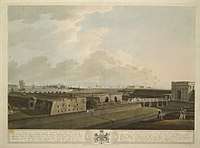 A view of Calcutta from Fort William, 1807.
A view of Calcutta from Fort William, 1807. Government House, Fort St. George, Madras, the headquarters of the Madras Presidency.
Government House, Fort St. George, Madras, the headquarters of the Madras Presidency. Warren Hastings, the first Governor-General of Fort William (Bengal) who oversaw the Company's territories in India.
Warren Hastings, the first Governor-General of Fort William (Bengal) who oversaw the Company's territories in India. The trial of Warren Hastings in the Court of Westminster Hall, 1789.
The trial of Warren Hastings in the Court of Westminster Hall, 1789.
Revenue collection
In the remnant of the Mughal Empire revenue system existing in pre-1765 Bengal, zamindars, or "land holders", collected revenue on behalf of the Mughal emperor, whose representative, or diwan, supervised their activities.[39] In this system, the assortment of rights associated with land were not possessed by a "land owner", but rather shared by the several parties with stake in the land, including the peasant cultivator, the zamindar, and the state.[40] The zamindar served as an intermediary who procured economic rent from the cultivator, and after withholding a percentage for his own expenses, made available the rest, as revenue to the state.[40] Under the Mughal system, the land itself belonged to the state and not to the zamindar, who could transfer only his right to collect rent.[40] On being awarded the diwani or overlordship of Bengal following the Battle of Buxar in 1764, the East India Company found itself short of trained administrators, especially those familiar with local custom and law; tax collection was consequently farmed out. This uncertain foray into land taxation by the Company, may have gravely worsened the impact of a famine that struck Bengal in 1769–70, in which between seven and ten million people—or between a quarter and third of the presidency's population—may have died.[41] However, the company provided little relief either through reduced taxation or by relief efforts,[42] and the economic and cultural impact of the famine was felt decades later, even becoming, a century later, the subject of Bankim Chandra Chatterjee's novel Anandamath.[41]
In 1772, under Warren Hastings, the East India Company took over revenue collection directly in the Bengal Presidency (then Bengal and Bihar), establishing a Board of Revenue with offices in Calcutta and Patna, and moving the pre-existing Mughal revenue records from Murshidabad to Calcutta.[43] In 1773, after Oudh ceded the tributary state of Benaras, the revenue collection system was extended to the territory with a Company Resident in charge.[43] The following year—with a view to preventing corruption—Company district collectors, who were then responsible for revenue collection for an entire district, were replaced with provincial councils at Patna, Murshidabad, and Calcutta, and with Indian collectors working within each district.[43] The title, "collector", reflected "the centrality of land revenue collection to government in India: it was the government's primary function and it moulded the institutions and patterns of administration".[44]
The Company inherited a revenue collection system from the Mughals in which the heaviest proportion of the tax burden fell on the cultivators, with one-third of the production reserved for imperial entitlement; this pre-colonial system became the Company revenue policy's baseline.[45] However, there was vast variation across India in the methods by which the revenues were collected; with this complication in mind, a Committee of Circuit toured the districts of expanded Bengal Presidency in order to make a five-year settlement, consisting of five-yearly inspections and temporary tax farming.[46] In their overall approach to revenue policy, Company officials were guided by two goals: first, preserving as much as possible the balance of rights and obligations that were traditionally claimed by the farmers who cultivated the land and the various intermediaries who collected tax on the state's behalf and who reserved a cut for themselves; and second, identifying those sectors of the rural economy that would maximise both revenue and security.[45] Although their first revenue settlement turned out to be essentially the same as the more informal pre-existing Mughal one, the Company had created a foundation for the growth of both information and bureaucracy.[45]
In 1793, the new Governor-General, Lord Cornwallis, promulgated the permanent settlement of land revenues in the presidency, the first socio-economic regulation in colonial India.[43] By the terms of the settlement Rajas and Taluqdars were recognised as Zamindars and they were asked to collect the rent from the peasants and pay revenue to the Company. It was named permanent because it fixed the land tax in perpetuity in return for landed property rights for zamindars; it simultaneously defined the nature of land ownership in the presidency, and gave individuals and families separate property rights in occupied land. Since the revenue was fixed in perpetuity, it was fixed at a high level, which in Bengal amounted to £3 million at 1789–90 prices. According to the Permanent Settlement if the Zamindars failed to pay the revenue on time, the Zmaindari right would be taken from them.[47] According to one estimate,[48] this was 20% higher than the revenue demand before 1757. Over the next century, partly as a result of land surveys, court rulings, and property sales, the change was given practical dimension.[49] An influence on the development of this revenue policy were the economic theories then current, which regarded agriculture as the engine of economic development, and consequently stressed the fixing of revenue demands in order to encourage growth.[50] The expectation behind the permanent settlement was that knowledge of a fixed government demand would encourage the zamindars to increase both their average outcrop and the land under cultivation, since they would be able to retain the profits from the increased output; in addition, it was envisaged that land itself would become a marketable form of property that could be purchased, sold, or mortgaged.[45] A feature of this economic rationale was the additional expectation that the zamindars, recognising their own best interest, would not make unreasonable demands on the peasantry.[51]
However, these expectations were not realised in practice, and in many regions of Bengal, the peasants bore the brunt of the increased demand, there being little protection for their traditional rights in the new legislation.[51] Forced labour of the peasants by the zamindars became more prevalent as cash crops were cultivated to meet the Company revenue demands.[45] Although commercialised cultivation was not new to the region, it had now penetrated deeper into village society and made it more vulnerable to market forces.[45] The zamindars themselves were often unable to meet the increased demands that the Company had placed on them; consequently, many defaulted, and by one estimate, up to one-third of their lands were auctioned during the first three decades following the permanent settlement.[52] The new owners were often Brahmin and Kayastha employees of the Company who had a good grasp of the new system, and, in many cases, some had prospered under it.[53]
Since the zamindars were never able to undertake costly improvements to the land envisaged under the Permanent Settlement, some of which required the removal of the existing farmers, they soon became rentiers who lived off the rent from their tenant farmers.[53] In many areas, especially northern Bengal, they had to increasingly share the revenue with intermediate tenure holders, called jotedars, who supervised farming in the villages.[53] Consequently, unlike the contemporaneous Enclosure movement in Britain, agriculture in Bengal remained the province of the subsistence farming of innumerable small paddy fields.[53]
The zamindari system was one of two principal revenue settlements undertaken by the Company in India.[54] In southern India, Thomas Munro, who would later become Governor of Madras, promoted the ryotwari system or the Munro system, in which the government settled land-revenue directly with the peasant farmers, or ryots.[42] It was first tried in small scale by Captain Alexander Read in the areas that were taken over from the wars with Tipu Sultan. Subsequently, developed by Thomas Munro, this system was gradually extended all over South India. This was, in part, a consequence of the turmoil of the Anglo-Mysore Wars, which had prevented the emergence of a class of large landowners; in addition, Munro and others felt that ryotwari was closer to traditional practice in the region and ideologically more progressive, allowing the benefits of Company rule to reach the lowest levels of rural society.[42] At the heart of the ryotwari system was a particular theory of economic rent—and based on David Ricardo's Law of Rent—promoted by utilitarian James Mill who formulated the Indian revenue policy between 1819 and 1830. "He believed that the government was the ultimate lord of the soil and should not renounce its right to 'rent', i.e. the profit left over on richer soil when wages and other working expenses had been settled."[55] Another keystone of the new system of temporary settlements was the classification of agricultural fields according to soil type and produce, with average rent rates fixed for the period of the settlement.[56] According to Mill, taxation of land rent would promote efficient agriculture and simultaneously prevent the emergence of a "parasitic landlord class".[55] Mill advocated ryotwari settlements which consisted of government measurement and assessment of each plot (valid for 20 or 30 years) and subsequent taxation which was dependent on the fertility of the soil.[55] The taxed amount was nine-tenths of the "rent" in the early 19th century and gradually fell afterwards.[55] However, in spite of the appeal of the ryotwari system's abstract principles, class hierarchies in southern Indian villages had not entirely disappeared—for example village headmen continued to hold sway—and peasant cultivators sometimes came to experience revenue demands they could not meet.[57] In the 1850s, a scandal erupted when it was discovered that some Indian revenue agents of the Company were using torture to meet the Company's revenue demands.[42]
Land revenue settlements constituted a major administrative activity of the various governments in India under Company rule.[12] In all areas other than the Bengal Presidency, land settlement work involved a continually repetitive process of surveying and measuring plots, assessing their quality, and recording landed rights, and constituted a large proportion of the work of Indian Civil Service officers working for the government.[12] After the Company lost its trading rights, it became the single most important source of government revenue, roughly half of overall revenue in the middle of the 19th century;[12] even so, between the years 1814 and 1859, the government of India ran debts in 33 years.[12] With expanded dominion, even during non-deficit years, there was just enough money to pay the salaries of a threadbare administration, a skeleton police force, and the army.[12]
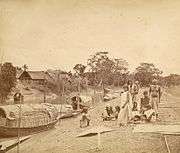 A riverside scene in rural east Bengal (present-day Bangladesh), 1860.
A riverside scene in rural east Bengal (present-day Bangladesh), 1860.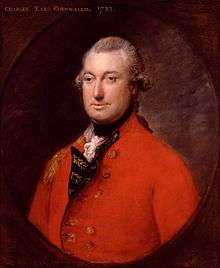 Charles Cornwallis, he was the Governor- General of India when Permanent Settlement was introduced.
Charles Cornwallis, he was the Governor- General of India when Permanent Settlement was introduced. A Kochh Mandai woman of east Bengal (now Bangladesh) with an agricultural knife and a freshly harvested jackfruit. (1860)
A Kochh Mandai woman of east Bengal (now Bangladesh) with an agricultural knife and a freshly harvested jackfruit. (1860)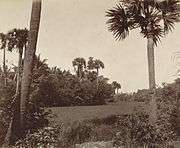 Paddy fields in the Madras Presidency, c. 1880. Two-thirds of the presidency fell under the Ryotwari system.
Paddy fields in the Madras Presidency, c. 1880. Two-thirds of the presidency fell under the Ryotwari system.
Army and civil service
In 1772, when Hastings became the first Governor-General one of his first undertakings was the rapid expansion of the Presidency's army. Since the available soldiers, or Sepoys, from Bengal—many of whom had fought against the British in the Battle of Plassey – were now suspect in British eyes, Hastings recruited farther west from the "major breeding ground" of India's infantry in eastern Awadh and the lands around Banaras including Bihar.[58] The high caste rural Hindu Rajputs and Brahmins of this region, known as Purbiyas (Hindi, lit. "easterners"), had been recruited by Mughal Empire armies for two hundred years;[58] the East India Company continued this practice for the next 75 years, with these soldiers comprising up to eighty per cent of the Bengal army.[58] However, in order to avoid any friction within the ranks, the Company also took pains to adapt its military practices to their religious requirements. Consequently, these soldiers dined in separate facilities; in addition, overseas service, considered polluting to their caste, was not required of them, and the army soon came to recognise Hindu festivals officially. "This encouragement of high caste ritual status, however, left the government vulnerable to protest, even mutiny, whenever the sepoys detected infringement of their prerogatives."[59]
| East India Company armies after the Re-organisation of 1796[60] | |||
|---|---|---|---|
| British troops | Indian troops | ||
| Bengal Presidency | Madras Presidency | Bombay Presidency | |
| 24,000 | 24,000 | 9,000 | |
| 13,000 | Total Indian troops: 57,000 | ||
| Grand total, British and Indian troops: 70,000 | |||
The Bengal Army was used in military campaigns in other parts of India and abroad: to provide crucial support to a weak Madras army in the Third Anglo-Mysore War in 1791, and also in Java and Ceylon.[58] In contrast to the soldiers in the armies of Indian rulers, the Bengal sepoys not only received high pay, but also received it reliably, thanks in great measure to the Company's access to the vast land-revenue reserves of Bengal.[58] Soon, bolstered both by the new musket technology and naval support, the Bengal army came to be widely well-regarded.[58] The well-disciplined sepoys attired in red-coats and their British officers began to arouse "a kind of awe in their adversaries. In Maharashtra and in Java, the sepoys were regarded as the embodiment of demonic forces, sometimes of antique warrior heroes. Indian rulers adopted red serge jackets for their own forces and retainers as if to capture their magical qualities."[58]
In 1796, under pressure from the Company's Board of Directors in London, the Indian troops were re-organised and reduced during the tenure of John Shore as Governor-General.[60] However, the closing years of the 18th century saw, with Wellesley's campaigns, a new increase in the army strength. Thus in 1806, at the time of the Vellore Mutiny, the combined strength of the three presidencies' armies stood at 154,500, making them one of the largest standing armies in the world.[61]
| East India Company armies on the eve of the Vellore Mutiny of 1806[62] | |||
|---|---|---|---|
| Presidencies | British troops | Indian troops | Total |
| Bengal | 7,000 | 57,000 | 64,000 |
| Madras | 11,000 | 53,000 | 64,000 |
| Bombay | 6,500 | 20,000 | 26,500 |
| Total | 24,500 | 130,000 | 154,500 |
As the East India Company expanded its territories, it added irregular "local corps", which were not as well trained as the army.[63] In 1846, after the Second Anglo-Sikh War, a frontier brigade was raised in the Cis-Sutlej Hill States mainly for police work; in addition, in 1849, the "Punjab Irregular Force" was added on the frontier.[63] Two years later, this force consisted of "3 light field batteries, 5 regiments of cavalry, and 5 of infantry".[63] The following year, "a garrison company was added, ... a sixth infantry regiment (formed from the Sind Camel Corps) in 1853, and one mountain battery in 1856".[63] Similarly, a local force was raised after the annexation of Nagpur in 1854, and the "Oudh Irregular Force" was added after Oudh was annexed in 1856.[63] Earlier, as a result of the treaty of 1800, the Nizam of Hyderabad had begun to maintain a contingent force of 9,000 horse and 6,000-foot which was commanded by Company officers; in 1853, after a new treaty was negotiated, this force was assigned to Berar and stopped being a part of the Nizam's army.[63]
| East India Company armies on the eve of the Indian rebellion of 1857[64] | |||||||||
|---|---|---|---|---|---|---|---|---|---|
| Presidencies | British troops | Indian troops | |||||||
| Cavalry | Artillery | Infantry | Total | Cavalry | Artillery | Sappers & Miners | Infantry | Total | |
| Bengal | 1,366 | 3,063 | 17,003 | 21,432 | 19,288 | 4,734 | 1,497 | 112,052 | 137,571 |
| Madras | 639 | 2,128 | 5,941 | 8,708 | 3,202 | 2,407 | 1,270 | 42,373 | 49,252 |
| Bombay | 681 | 1,578 | 7,101 | 9,360 | 8,433 | 1,997 | 637 | 33,861 | 44,928 |
| Local forces and contingents | 6,796 | 2,118 | 23,640 | 32,554 | |||||
| " " (unclassified) | 7,756 | ||||||||
| Military police | 38,977 | ||||||||
| Total | 2,686 | 6,769 | 30,045 | 39,500 | 37,719 | 11,256 | 3,404 | 211,926 | 311,038 |
| Grand Total, British and Indian troops | 350,538 | ||||||||
In the Indian rebellion of 1857 almost the entire Bengal army, both regular and irregular, revolted.[64] It has been suggested that after the annexation of Oudh by the East India Company in 1856, many sepoys were disquieted both from losing their perquisites, as landed gentry, in the Oudh courts and from the anticipation of any increased land-revenue payments that the annexation might augur.[65] With British victories in wars or with annexation, as the extent of British jurisdiction expanded, the soldiers were now not only expected to serve in less familiar regions (such as in Burma in the Anglo-Burmese Wars in 1856), but also make do without the "foreign service", remuneration that had previously been their due, and this caused resentment in the ranks.[66] The Bombay and Madras armies, and the Hyderabad contingent, however, remained loyal. The Punjab Irregular Force not only did not revolt, it played an active role in suppressing the mutiny.[64] The rebellion led to a complete re-organisation of the Indian army in 1858 in the new British Raj.
Civil service
The reforms initiated after 1784 were designed to create an elite civil service where very talented young Britons would spend their entire careers. Advanced training was promoted especially at the East India Company College (until 1853).[67] Haileybury emphasised the Anglican religion and morality and trained students in the classical Indian languages. Many students held to Whiggish, evangelical, and Utilitarian convictions of their duty to represent their nation and to modernise India. At most there were about 600 of these men who managed the Raj's customs service, taxes, justice system, and its general administration.[68][69] The Company's original policy was one of "Orientalism", that is of adjusting to the way of life and customs of the Indian people and not trying to reform them. That changed after 1813, as the forces of reform in the home country, especially evangelical religion, Whiggish political outlook, and Utilitarian philosophy worked together to make the Company an agent of Anglicization and modernisation. Christian missionaries became active, but made few converts. The Raj set out to outlaw sati (widow-burning) and thuggee (ritual banditry) and upgrade the status of women. Schools would be established in which they would teach the English language. The 1830s and 1840s, however, were not times of prosperity: After its heavy spending on the military, the Company had little money to engage in large-scale public works projects or modernisation programs.[70]
 A Royal Artillery encampment at Arcot, Madras Presidency, 1804.
A Royal Artillery encampment at Arcot, Madras Presidency, 1804.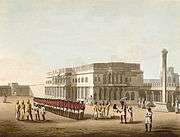 East India Company Sepoys (Indian infantrymen) in red coats outside Tipu Sultan's former summer palace in Bangalore, 1804
East India Company Sepoys (Indian infantrymen) in red coats outside Tipu Sultan's former summer palace in Bangalore, 1804 Military Orphan School for private soldiers of the East India Company, Howrah, Bengal Presidency, 1794.
Military Orphan School for private soldiers of the East India Company, Howrah, Bengal Presidency, 1794.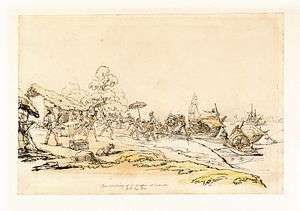 A new "writer" in the East India Company Civil Service arrives in Calcutta. A palanquin transport awaits him.
A new "writer" in the East India Company Civil Service arrives in Calcutta. A palanquin transport awaits him.
Trade
After gaining the right to collect revenue in Bengal in 1765, the Company largely ceased importing gold and silver, which it had hitherto used to pay for goods shipped back to Britain.[71]
| Years | Bullion (£) | Average per annum |
|---|---|---|
| 1708/9-1733/4 | 12,189,147 | 420,315 |
| 1734/5-1759/60 | 15,239,115 | 586,119 |
| 1760/1-1765/6 | 842,381 | 140,396 |
| 1766/7-1771/2 | 968,289 | 161,381 |
| 1772/3-1775/6 | 72,911 | 18,227 |
| 1776/7-1784/5 | 156,106 | 17,345 |
| 1785/6-1792/3 | 4,476,207 | 559,525 |
| 1793/4-1809/10 | 8,988,165 | 528,715 |
In addition, as under Mughal Empire rule, land revenue collected in the Bengal Presidency helped finance the Company's wars in other parts of India.[71] Consequently, in the period 1760–1800, Bengal's money supply was greatly diminished; furthermore, the closing of some local mints and close supervision of the rest, the fixing of exchange rates, and the standardisation of coinage, paradoxically, added to the economic downturn.[71] During the period, 1780–1860, India changed from being an exporter of processed goods for which it received payment in bullion, to being an exporter of raw materials and a buyer of manufactured goods.[71] More specifically, in the 1750s, mostly fine cotton and silk was exported from India to markets in Europe, Asia, and Africa; by the second quarter of the 19th century, raw materials, which chiefly consisted of raw cotton, opium, and indigo, accounted for most of India's exports.[73] Also, from the late 18th century British cotton mill industry began to lobby the government to both tax Indian imports and allow them access to markets in India.[73] Starting in the 1830s, British textiles began to appear in—and soon to inundate—the Indian markets, with the value of the textile imports growing from £5.2 million 1850 to £18.4 million in 1896.[74] The American Civil War too would have a major impact on India's cotton economy: with the outbreak of the war, American cotton was no longer available to British manufacturers; consequently, demand for Indian cotton soared, and the prices soon quadrupled.[75] This led many farmers in India to switch to cultivating cotton as a quick cash crop; however, with the end of the war in 1865, the demand plummeted again, creating another downturn in the agricultural economy.[73]
At this time, the East India Company's trade with China began to grow as well. In the early 19th century demand for Chinese tea had greatly increased in Britain; since the money supply in India was restricted and the Company was indisposed to shipping bullion from Britain, it decided upon opium, which had a large underground market in China and which was grown in many parts of India, as the most profitable form of payment.[76] However, since the Chinese authorities had banned the importation and consumption of opium, the Company engaged them in the First Opium War, and at its conclusion, under the Treaty of Nanjing, gained access to five Chinese ports, Guangzhou, Xiamen, Fuzhou, Shanghai, and Ningbo; in addition, Hong Kong was ceded to the British Crown.[76] Towards the end of the second quarter of the 19th century, opium export constituted 40% of India's exports.[77]
Another major, though erratic, export item was indigo dye, which was extracted from natural indigo, and which came to be grown in Bengal and northern Bihar.[78] In late 17th and early 18th century Europe, blue clothing was favoured as a fashion, and blue uniforms were common in the military; consequently, the demand for the dye was high.[79] In 1788, the East India Company offered advances to ten British planters to grow indigo; however, since the new (landed) property rights defined in the Permanent Settlement, did not allow them, as Europeans, to buy agricultural land, they had to in turn offer cash advances to local peasants, and sometimes coerce them, to grow the crop.[80] The European demand for the dye, however, proved to be unstable, and both creditors and cultivators bore the risk of the market crashes in 1827 and 1847.[78] The peasant discontent in Bengal eventually led to the Indigo rebellion in 1859–60 and to the end of indigo production there.[81] In Bihar, however, indigo production continued well into the 20th century; the centre of indigo production there, Champaran district, became the staging ground, in 1917, for Mohandas Karamchand Gandhi's first experiment in non-violent resistance against the British Raj.[79]
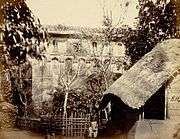 Photograph of East India Company factory in Painam, Sonargaon, Bangladesh, a major producer of the celebrated Dhaka muslins.
Photograph of East India Company factory in Painam, Sonargaon, Bangladesh, a major producer of the celebrated Dhaka muslins. "Mellor Mill" in Marple, Greater Manchester, England, was constructed in 1790–1793 for manufacturing muslin cloth.
"Mellor Mill" in Marple, Greater Manchester, England, was constructed in 1790–1793 for manufacturing muslin cloth.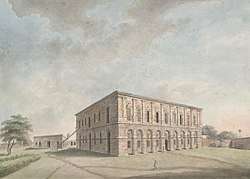 Opium Godown (Storehouse) in Patna, Bihar (c. 1814). Patna was the centre of the Company opium industry.
Opium Godown (Storehouse) in Patna, Bihar (c. 1814). Patna was the centre of the Company opium industry.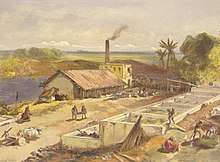 Indigo dye factory in Bengal. Bengal was the world's largest producer of natural indigo in the 19th century.
Indigo dye factory in Bengal. Bengal was the world's largest producer of natural indigo in the 19th century.
Justice system
Until the British gained control of Bengal in the mid-18th century, the system of justice there was presided over by the Nawab of Bengal himself, who, as the chief law officer, Nawāb Nāzim, attended to cases qualifying for capital punishment in his headquarters, Murshidabad. His deputy, the Naib Nāzim, attended to the slightly less important cases. The ordinary lawsuits belonged to the jurisdiction of a hierarchy of court officials consisting of faujdārs, muhtasils, and kotwāls. In the rural areas, or the Mofussil, the zamindars—the rural overlords with the hereditary right to collect rent from peasant farmers—also had the power to administer justice. This they did with little routine oversight, being required to report only their judgments in capital punishment cases to the Nawāb.
By the mid-18th century, the British too had completed a century and a half in India, and had a burgeoning presence in the three presidency towns of Madras, Bombay, and Calcutta. During this time the successive Royal Charters had gradually given the East India Company more power to administer justice in these towns. In the charter granted by Charles II in 1683, the Company was given the power to establish "courts of judicature" in locations of its choice, each court consisting of a lawyer and two merchants. This right was renewed in the subsequent charters granted by James II and William III in 1686 and 1698 respectively. In 1726, however, the Court of Directors of the Company felt that more customary justice was necessary for European residents in the presidency towns, and petitioned the King to establish Mayor's Courts. The petition was approved and Mayor's courts, each consisting of a Mayor and nine aldermen, and each having the jurisdiction in lawsuits between Europeans, were created in Fort William (Calcutta), Madras, and Bombay. Judgments handed down by a Mayor's Court could be disputed with an appeal to the respective Presidency government and, when the amount disputed was greater than Rs. 4,000, with a further appeal to the King-in-Council. In 1753, the Mayor's courts were renewed under a revised letters patent; in addition, Courts of Requests for lawsuits involving amounts less than Rs. 20 were introduced. Both types of courts were regulated by the Court of Directors of the East India Company.
After its victory in the Battle of Buxar, the Company obtained in 1765 the Diwāni of Bengal, the right not only to collect revenue, but also to administer civil justice in Bengal. The administration of criminal justice, the Nizāmat or Faujdāri, however, remained with the Nawāb, and for criminal cases the prevailing Islamic law remained in place. However, the Company's new duties associated with the Diwāni were leased out to the Indian officials who had formerly performed them. This makeshift arrangement continued—with much accompanying disarray—until 1771, when the Court of Directors of the Company decided to obtain for the Company the jurisdiction of both criminal and civil cases.
Soon afterwards Warren Hastings arrived in Calcutta as the first Governor-General of the Company's Indian dominions and resolved to overhaul the Company's organisation and in particular its judicial affairs. In the interior, or Mofussil, diwāni adālats, or a civil courts of first instance, were constituted in each district; these courts were presided over by European Zilā judges employed by the Company, who were assisted in the interpretation of customary Indian law by Hindu pandits and Muslim qazis. For small claims, however, Registrars and Indian commissioners, known as Sadr Amīns and Munsifs, were appointed. These in their turn were supervised by provincial civil courts of appeal constituted for such purpose, each consisting of four British judges. All these were under the authority of the Sadr Diwāni Adālat, or the Chief Civil Court of Appeals, consisting of the Governor of the Presidency and his Council, assisted by Indian officers.
Similarly for criminal cases, Mofussil nizāmat adālats, or Provincial courts of criminal judicature, were created in the interior; these again consisted of Indian court officers (pandits and qazis), who were supervised by officials of the Company. Also constituted were Courts of circuit with appellate jurisdiction in criminal cases, which were usually presided over by the judges of the civil appellate courts. All these too were under a Sadr Nizāmat Adālat or a Chief Court of Criminal Appeal.
Around this time the business affairs of the East India Company began to draw increased scrutiny in the House of Commons. After receiving a report by a committee, which condemned the Mayor's Courts, the Crown issued a charter for a new judicial system in the Bengal Presidency. The British Parliament consequently enacted the Regulating Act of 1773 under which the King-in-Council created a Supreme Court in the Presidency town, i.e. Fort William. The tribunal consisted of one Chief Justice and three puisne judges; all four judges were to be chosen from barristers. The Supreme Court supplanted the Mayor's Court; however, it left the Court of Requests in place. Under the charter, the Supreme Court, moreover, had the authority to exercise all types of jurisdiction in the region of Bengal, Bihar, and Odisha, with the only caveat that in situations where the disputed amount was in excess of Rs. 4,000, their judgment could be appealed to the Privy Council. Both the Act and the charter said nothing about the relation between the judiciary (Supreme Court) and the executive branch (Governor-General); equally, they were silent on the Adālats (both Diwāni and Nizāmat) created by Warren Hastings just the year before. In the new Supreme Court, the civil and criminal cases alike were interpreted and prosecuted accorded to English law; in the Sadr Adālats, however, the judges and law-officers had no knowledge of English law, and were required only, by the Governor-General's order, "to proceed according to equity, justice, and good conscience, unless Hindu or Muhammadan law was in point, or some Regulation expressly applied".
There was a good likelihood, therefore, that the Supreme Court and the Sadr Adālats would act in opposition to each other and, predictably, many disputes resulted. Hastings' premature attempt to appoint the Chief Justice, Sir Elijah Impey, an old schoolmate from Winchester, to the bench of the Sadr Diwāni Adālat, only complicated the situation further. The appointment had to be annulled in 1781 by a parliamentary intervention with the enactment of the Declaration Act. The Act exempted the Executive Branch from the jurisdiction of the Supreme Court. It recognised the independent existence of the Sadr Adālats and all subsidiary courts of the Company. Furthermore, it headed off future legal turf wars by prohibiting the Supreme Court any jurisdiction in matters of revenue (Diwāni) or Regulations of the Government enacted by the British Parliament. This state of affairs continued until 1797, when a new Act extended the jurisdiction of the Supreme Court to the province of Benares (which had since been added to the Company's dominions) and "all places for the time being included in Bengal". With the constituting of the Ceded and Conquered Provinces in 1805, the jurisdiction would extend as far west as Delhi.
In the other two presidencies, Madras and Bombay, a similar course of legal changes unfolded; there, however, the Mayor's Courts were first strengthened to Recorder's Courts by adding a legal president to the bench. The Supreme Courts in Madras and Bombay were finally established in 1801 and 1823, respectively. Madras Presidency was also unusual in being the first to rely on village headmen and panchāyats for cases involving small claims. This judicial system in the three presidencies was to survive the Company's rule, the next major change coming only in 1861.
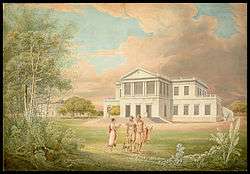 The house of Sir Thomas Strange, who in 1800 became the first Chief Justice of the Fort of St. George (Madras) and wrote Elements of Hindu Law (1825).
The house of Sir Thomas Strange, who in 1800 became the first Chief Justice of the Fort of St. George (Madras) and wrote Elements of Hindu Law (1825).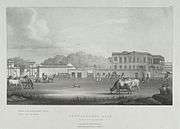 An 1833 Lithograph of the Sadr Diwāni Adālat, the Chief Civil Court for Indians, on Chowringhee Road, Calcutta.
An 1833 Lithograph of the Sadr Diwāni Adālat, the Chief Civil Court for Indians, on Chowringhee Road, Calcutta.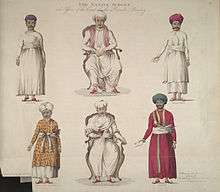 Coloured engraving of the judges and officers of Hindu (top row) and Muslim (bottom row) law in the Recorder Court in Bombay, 1805.
Coloured engraving of the judges and officers of Hindu (top row) and Muslim (bottom row) law in the Recorder Court in Bombay, 1805.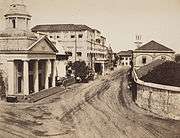 The Court-House Building on Apollo Street, Bombay (third building on left, just beyond the domed Ice House) shown in 1850.
The Court-House Building on Apollo Street, Bombay (third building on left, just beyond the domed Ice House) shown in 1850.
Education
Education of Indians had become a topic of interest among East India Company officials from the outset of the Company's rule in Bengal.[82] In the last two decades of the 18th century and the first decade of the nineteenth, Company officials pursued a policy of conciliation towards the native culture of its new dominion, especially in relation to education policy.[82] During the 19th century, the Indian literacy rates were rumoured to be less than half of post independence levels which were 18.33% in 1951. The policy was pursued in the aid of three goals: "to sponsor Indians in their own culture, to advance knowledge of India, and to employ that knowledge in government".[82]
The first goal was supported by some administrators, such as Warren Hastings, who envisaged the Company as the successor of a great Empire, and saw the support of vernacular learning as only befitting that role. In 1781, Hastings founded the Madrasa 'Aliya, an institution in Calcutta for the study of Arabic and Persian languages, and Islamic law. A few decades later a related perspective appeared among the governed population, one that was expressed by the conservative Bengali reformer Radhakanta Deb as the "duty of the Rulers of Countries to preserve and Customs and the religions of their subjects".
The second goal was motivated by the concerns among some Company officials about being seen as foreign rulers. They argued that the Company should try to win over its subjects by outdoing the region's previous rulers in the support of indigenous learning. Guided by this belief, the Benares Sanskrit College was founded in Varanasi in 1791 during the administration of Lord Cornwallis. The promotion of knowledge of Asia had attracted scholars as well to the Company's service. Earlier, in 1784, the Asiatick Society had been founded in Calcutta by William Jones, a puisne judge in the newly established Supreme Court of Bengal. Soon, Jones was to advance his famous thesis on the common origin of Indo-European languages.
The third related goal grew out of the philosophy then current among some Company officials that they would themselves become better administrators if they were better versed in the languages and cultures of India. It led in 1800 to the founding of the College of Fort William, in Calcutta by Lord Wellesley, the then Governor-General. The College was later to play an important role both in the development of modern Indian languages and in the Bengal Renaissance. Advocates of these related goals were termed, "Orientalists". The Orientalist group was led by Horace Hayman Wilson. Many leading Company officials, such as Thomas Munro and Montstuart Elphinstone, were influenced by the Orientalist ethos and felt that the Company's government in India should be responsive to Indian expectations. The Orientalist ethos would prevail in education policy well into the 1820s, and was reflected in the founding of the Poona Sanskrit College in Pune in 1821 and the Calcutta Sanskrit College in 1824.
The Orientalists were, however, soon opposed by advocates of an approach that has been termed Anglicist. The Anglicists supported instruction in the English language in order to impart to Indians what they considered modern Western knowledge. Prominent among them were evangelicals who, after 1813—when the Company's territories were opened to Christian missionaries—were interested in spreading Christian belief; they also believed in using theology to promote liberal social reform, such as the abolition of slavery. Among them was Charles Grant, the Chairman of the East India Company. Grant supported state-sponsored education in India 20 years before a similar system was set up in Britain. Among Grant's close evangelical friends were William Wilberforce, a prominent abolitionist and member of the British Parliament, and Sir John Shore, the Governor-General of India from 1793 to 1797. During this period, many Scottish Presbyterian missionaries also supported the British rulers in their efforts to spread English education and established many reputed colleges like Scottish Church College (1830), Wilson College (1832), Madras Christian College (1837), and Elphinstone College (1856).
However, the Anglicists also included utilitarians, led by James Mill, who had begun to play an important role in fashioning Company policy. The utilitarians believed in the moral worth of an education that aided the good of society and promoted instruction in useful knowledge. Such useful instruction to Indians had the added consequence of making them more suitable for the Company's burgeoning bureaucracy. By the early 1830s, the Anglicists had the upper hand in devising education policy in India. Many utilitarian ideas were employed in Thomas Babbington Macaulay's Minute on Indian Education of 1835. The Minute, which later aroused great controversy, was to influence education policy in India well into the next century.
Since English was increasingly being employed as the language of instruction, Persian was abolished as the official language of the Company's administration and courts by 1837. However, bilingual educations was proving to be popular as well, and some institutions such as the Poona Sanskrit College commenced teaching both Sanskrit and English. Charles Grant's son, Sir Robert Grant, who in 1834 was appointed Governor of the Bombay Presidency, played an influential role in the planning of the first medical college in Bombay, which after his unexpected death was named Grant Medical College when it was established in 1845. During 1852–1853 some citizens of Bombay sent petitions to the British Parliament in support of both establishing and adequately funding university education in India. The petitions resulted in the Education Dispatch of July 1854 sent by Sir Charles Wood, the President of the Board of Control of the East India Company, the chief official on Indian affairs in the British government, to Lord Dalhousie, the then Governor-General of India. The dispatch outlined a broad plan of state-sponsored education for India, which included:[83]
- Establishing a Department of Public Instruction in each presidency or province of British India.
- Establishing universities modelled on the University of London (as primarily examining institutions for students studying in affiliated colleges) in each of the Presidency towns (i.e. Madras, Bombay, and Calcutta)
- Establishing teachers-training schools for all levels of instruction
- Maintaining existing Government colleges and high-schools and increasing their number when necessary.
- Vastly increasing vernacular schools for elementary education in villages.
- Introducing a system of grants-in-aid for private schools.
The Department of Public Instruction was in place by 1855. In January 1857, the University of Calcutta was established, followed by the University of Bombay in June 1857, and the University of Madras in September 1857. The University of Bombay, for example, consisted of three affiliated institutions: the Elphinstone Institution, the Grant Medical College, and the Poona Sanskrit College. The Company's administration also founded high-schools en masse in the different provinces and presidencies, and the policy was continued during Crown rule which commenced in 1858. By 1861, 230,000 students were attending public educational institutions in the four provinces (the three Presidencies and North-Western Provinces), of whom 200,000 were in primary schools.[84] Over 5,000 primary schools and 142 secondary schools had been established in these provinces.[84] Earlier, during the Indian rebellion of 1857, some civilian leaders, such as Khan Bhadur Khan of Bareilly, had stressed the threat posed to the populace's religions by the new education programmes begun by the Company; however, historical statistics have shown that this was not generally the case. For example, in Etawah district in the then North-Western Provinces (present-day Uttar Pradesh), where during the period 1855–1857, nearly 200 primary, middle-, and high-schools had been opened by the Company and tax levied on the population, relative calm prevailed and the schools remained open during the rebellion.[85]
 A coloured-in photograph (1851) of Hindu College, Calcutta, which had been founded in 1817 by a committee headed by Raja Ram Mohun Roy. In 1855, the Government of the Bengal Presidency renamed it Presidency College and opened it to all students.
A coloured-in photograph (1851) of Hindu College, Calcutta, which had been founded in 1817 by a committee headed by Raja Ram Mohun Roy. In 1855, the Government of the Bengal Presidency renamed it Presidency College and opened it to all students. An engraving (1844) of a youth, who according to the engraver, Emily Eden, was "a favourite and successful young student at the Hindu College in Calcutta, where scholars acquire a very perfect knowledge of English, and have a familiarity with the best English writers".
An engraving (1844) of a youth, who according to the engraver, Emily Eden, was "a favourite and successful young student at the Hindu College in Calcutta, where scholars acquire a very perfect knowledge of English, and have a familiarity with the best English writers". An 1844 engraving of Grant Medical College (left) and Sir Jamsetjee Jeejeebhoy Hospital (right background) in Bombay made by G. R. Sargeant the year before the medical college was formally opened.
An 1844 engraving of Grant Medical College (left) and Sir Jamsetjee Jeejeebhoy Hospital (right background) in Bombay made by G. R. Sargeant the year before the medical college was formally opened.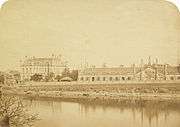 An 1855 photograph of the same two institutions. In 1857, Grant Medical College became one of three institutions affiliated with the newly established University of Bombay. The college was funded partly by the Jeejeebhoy family and partly by the East India Company.
An 1855 photograph of the same two institutions. In 1857, Grant Medical College became one of three institutions affiliated with the newly established University of Bombay. The college was funded partly by the Jeejeebhoy family and partly by the East India Company.
Social reform
In the first half of the 19th century, the British legislated reforms against what they considered were iniquitous Indian practices. In most cases, the legislation alone was unable to change Indian society sufficiently for it to absorb both the ideal and the ethic underpinning the reform. For example, upper-caste Hindu society had long looked askance at the remarriage of widows in order to protect both what it considered was family honour and family property. Even adolescent widows were expected to live a life of austerity and denial. The Hindu Widows' Remarriage Act, 1856, enacted in the waning years of Company rule, provided legal safeguards against loss of certain forms of inheritance for a remarrying Hindu widow, though not of the inheritance due her from her deceased husband. However, very few widows actually remarried. Some Indian reformers, such as Raja Ram Mohan Roy, Ishwar Chandra Vidyasagar, even offered money to men who would take widows as brides, but these men often deserted their new wives.
Post and telegraph
Postal services
Before 1837, the East India Company's dominions in India had no universal public postal service, one that was shared by all regions. Although courier services did exist, connecting the more important towns with their respective seats of provincial government (i.e. the Presidency towns of Fort William (Calcutta), Fort St. George (Madras), and Bombay), private individuals were, upon payment, only sparingly allowed their use. That situation changed in 1837, when, by Act XVII of that year, a public post, run by the Company's Government, was established in the Company's territory in India. Post offices were established in the principal towns and postmasters appointed. The postmasters of the Presidency towns oversaw a few provincial post offices in addition to being responsible for the main postal services between the provinces. By contrast, the District collectors (originally, collectors of land-tax) directed the District post offices, including their local postal services. Postal services required payment in cash, to be made in advance, with the amount charged usually varying with weight and distance. For example, the charge of sending a letter from Calcutta to Bombay was one rupee; however, that from Calcutta to Agra was 12 annas (or three-quarter of a rupee) for each tola (three-eighths of an ounce).[86][87]
After the recommendations of the commission appointed in 1850 to evaluate the Indian postal system were received, Act XVII of 1837 was superseded by the Indian Postal Act of 1854. Under its provisions, the entire postal department was headed by a Director-General, and the duties of a Postmaster-General were set apart from those of a Presidency Postmaster; the former administered the postal system of the larger provinces (such as the Bombay Presidency or the North-Western Provinces), whereas the latter attended to the less important Provinces (such as Ajmer-Merwara and the major Political Agencies such as Rajputana). Postage stamps were introduced at this time and the postal rates fixed by weight, dependent no longer also on the distance travelled in the delivery. The lowest inland letter rate was half anna for 1⁄4 tola, followed by one anna for 1⁄2 tola, and 2 annas for a tola, a great reduction from the rates of 17 years before. The Indian Post Office delivered letters, newspapers, postcards, book packets, and parcels. These deliveries grew steadily in number; by 1861 (three years after the end of Company rule), a total of 889 post offices had been opened, and almost 43 million letters and over four and a half million newspapers were being delivered annually.[88]
 Lithograph of the General Post Office on Chowringhee Street, Calcutta, 1833, four years before the India-wide postal service was established under the Indian Postal Act of 1837.
Lithograph of the General Post Office on Chowringhee Street, Calcutta, 1833, four years before the India-wide postal service was established under the Indian Postal Act of 1837. Two four anna stamps issued in 1854. Stamps were issued for the first time for all of British India in 1854. The lowest denomination was 1⁄2 anna blue, followed by 1 anna red, and 4 annas blue and red. The stamps were printed from lithographic stones at the Surveyor-General's Office in Calcutta.
Two four anna stamps issued in 1854. Stamps were issued for the first time for all of British India in 1854. The lowest denomination was 1⁄2 anna blue, followed by 1 anna red, and 4 annas blue and red. The stamps were printed from lithographic stones at the Surveyor-General's Office in Calcutta.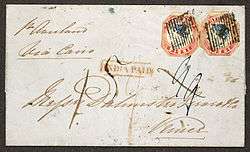 Since the four anna stamps were composed of two colours, they required two different printings, one for Queen Victoria's head in blue, and the other for the surrounding red frame. In these, rare stamps, shown on a letter mailed from Bombay to Venice, the head was accidentally oriented upside-down in relation to the frame.
Since the four anna stamps were composed of two colours, they required two different printings, one for Queen Victoria's head in blue, and the other for the surrounding red frame. In these, rare stamps, shown on a letter mailed from Bombay to Venice, the head was accidentally oriented upside-down in relation to the frame.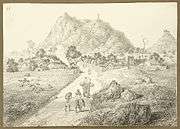 A semaphore "telegraph" signalling tower in Silwar (Bihar), 13 February 1823, thirty years before electric telegraphy was rapidly introduced into India by the East India Company.
A semaphore "telegraph" signalling tower in Silwar (Bihar), 13 February 1823, thirty years before electric telegraphy was rapidly introduced into India by the East India Company.
Telegraphy
Before the advent of electric telegraphy, the word "telegraph" had been used for semaphore signalling. During the period 1820–1830, the East India Company's Government in India seriously considered constructing signalling towers ("telegraph" towers), each a hundred feet high and separated from the next by eight miles, along the entire distance from Calcutta to Bombay. Although such towers were built in Bengal and Bihar, the India-wide semaphore network never took off. By mid-century, electric telegraphy had become viable, and hand signalling obsolete.
W. B. O'Shaughnessy, a Professor of Chemistry in the Calcutta Medical College, received permission in 1851 to conduct a trial run for a telegraph service from Calcutta to Diamond Harbour along the river Hooghly. Four telegraph offices, mainly for shipping-related business, were also opened along the river that year. The telegraph receiver used in the trial was a galvanoscope of Dr. O'Shaughnessy's design and manufactured in India. When the experiment was deemed to be a success a year later, the Governor-General of India, Lord Dalhousie, sought permission from the Court of Directors of the Company for the construction of telegraph lines from "Calcutta to Agra, Agra to Bombay, Agra to Peshawar, and Bombay to Madras, extending in all over 3,050 miles and including forty-one offices". The permission was soon granted; by February 1855 all the proposed telegraph lines had been constructed and were being used to send paid messages. Dr. O'Shaughnessy's instrument was used all over India until early 1857, when it was supplanted by the Morse instrument. By 1857, the telegraph network had expanded to 4,555 miles of lines and sixty two offices, and had reached as far as the hill station of Ootacamund in the Nilgiri Hills and the port of Calicut on the southwest coast of India. During the Indian rebellion of 1857, more than seven hundred miles of telegraph lines were destroyed by the rebel forces, mainly in the North-Western Provinces. The East India Company was nevertheless able to use the remaining intact lines to warn many outposts of impending disturbances. The political value of the new technology was, thus, driven home to the Company, and, in the following year, not only were the destroyed lines rebuilt, but the network was expanded further by 2,000 miles.[89]
O'Shaughnessy's experimental set-up of 1851–52 consisted of both overhead and underground lines; the latter included underwater ones that crossed two rivers, the Hooghly and the Haldi. The overhead line was constructed by welding uninsulated iron rods, 13 1⁄2 feet long and 3/8 inch wide, end to end. These lines, which weighed 1,250 pounds per mile, were held aloft by fifteen-foot lengths of bamboo, planted into the ground at equal intervals—200 to the mile—and covered with a layer each of coal tar and pitch for insulation. The underwater cables had been manufactured in England and consisted of copper wire covered with gutta-percha. Furthermore, in order to protect the cables from dragging ship anchors, the cables were attached to the links of a 7⁄8-inch-thick (22 mm) chain cable. An underwater cable of length 2,070 yards was laid across the Hooghly river at Diamond Harbour, and another, 1,400 yards long, was laid across the Haldi at Kedgeree.
Work on the long lines from Calcutta to Peshawar (through Agra), Agra to Bombay, and Bombay to Madras began in 1853. The conducting material chosen for these lines was now lighter, and the support stronger. The wood used for the support consisted of teak, sal, fir, ironwood, or blackwood (Terminalia elata), and was either fashioned into whole posts, or used in attachments to iron screw-piles or masonry columns. Some sections had uniformly strong support; one such was the 322-mile Bombay-Madras line, which was supported by granite obelisks sixteen feet high. Other sections had less secure support, consisting, in some cases, of sections of toddy palm, insulated with pieces of sal wood fastened to their tops. Some of the conducting wires or rods were insulated, the insulating material being manufactured in either India or England; other stretches of wire remained uninsulated. By 1856, iron tubes had begun to be employed to provide support, and would see increased use in the second half of the 19th century all over India.
The first Telegraph Act for India was Parliament's Act XXXIV of 1854. When the public telegramme service was first set up in 1855, the charge was fixed at one rupee for every sixteen words (including the address) for every 400 miles of transmission. The charges were doubled for telegrammes sent between 6PM and 6AM. These rates would remain fixed until 1882. In the year 1860–61, two years after the end of Company rule, India had 11,093 miles of telegraph lines and 145 telegraph offices. That year telegrams totalling Rs. 500,000 in value were sent by the public, the working expense of the Indian Telegraph Department was Rs. 1.4 million, and the capital expenditure until the end of the year totalled Rs. 6.5 million.
Railways
The first inter-city railway service in England, the Stockton and Darlington railway, had been established in 1825;[90] in the following decade other inter-city railways were rapidly constructed between cities in England. In 1845, the Court of Directors of the East India Company, forwarded to the Governor-General of India, Lord Dalhousie, a number of applications they had received from private contractors in England for the construction of a wide-ranging railway network in India, and requested a feasibility report. They added that, in their view, the enterprise would be profitable only if large sums of money could be raised for the construction. The Court was concerned that in addition to the usual difficulties encountered in the construction of this new form of transportation, India might present some unique problems, among which they counted floods, tropical storms in coastal areas, damage by "insects and luxuriant tropical vegetation", and the difficulty of finding qualified technicians at a reasonable cost. It was suggested, therefore, that three experimental lines be constructed and their performance evaluated.[91]
Contracts were awarded in 1849 to the East Indian Railway Company to construct a 120-mile railway from Howrah-Calcutta to Raniganj; to the Great Indian Peninsular Railway Company for a service from Bombay to Kalyan, thirty miles away; and to the Madras Railway Company for a line from Madras city to Arkonam, a distance of some thirty nine miles. Although construction began first, in 1849, on the East Indian Railways line, with an outlay of £1 million, it was the first-leg of the Bombay-Kalyan line—a 21-mile stretch from Bombay to Thane—that, in 1853, was the first to be completed (see picture below).
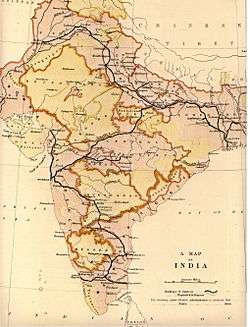
The feasibility of a train network in India was comprehensively discussed by Lord Dalhousie in his Railway minute of 1853. The Governor-General vigorously advocated the quick and widespread introduction of railways in India, pointing to their political, social, and economic advantages. He recommended that a network of trunk lines be first constructed connecting the inland regions of each presidency with its chief port as well as each presidency with several others. His recommended trunk lines included the following ones: (i) from Calcutta, in the Bengal Presidency, on the eastern coast to Lahore in the north-western region of the Punjab, annexed just three years before; (ii) from Agra in north-central India (in, what was still being called North-Western Provinces) to Bombay city on the western coast; (iii) from Bombay to Madras city on the southeastern coast; and (iv) from Madras to the southwestern Malabar coast (see map above). The proposal was soon accepted by the Court of Directors.
During this time work had been proceeding on the experimental lines as well. The first leg of the East Indian Railway line, a broad gauge railway, from Howrah to Pandua, was opened in 1854 (see picture of locomotive below), and the entire line up to Raniganj would become functional by the time of the Indian rebellion of 1857. The Great Indian Peninsular Railway was permitted to extend its experimental line to Poona. This extension required planning for the steep rise in the Bor Ghat valley in the Western Ghats, a section 15 3⁄4 miles long with an ascent of 1,831 feet. Construction began in 1856 and was completed in 1863, and, in the end, the line required a total of twenty five tunnels and fifteen miles of gradients (inclines) of 1 in 50 or steeper, the most extreme being the Bor Ghat Incline, a distance of 1 3⁄4 miles at a gradient of 1 in 37 (see picture above).
Each of the three companies (and later five others that were given contracts in 1859) was a joint stock company domiciled in England with its financial capital raised in pounds sterling. Each company was guaranteed a 5 per cent return on its capital outlay and, in addition, a share of half the profits. Although the Government of India had no capital expenditure other than the provision of the underlying land free of charge, it had the onus of continuing to provide the 5 percent return in the event of net loss, and soon all anticipation of profits would fall by the wayside as the outlays would mount.
The technology of railway construction was still new and there was no railway engineering expertise in India; consequently, all engineers had to be brought in from England. These engineers were unfamiliar not only with the language and culture of India, but also with the physical aspect of the land itself and its concomitant engineering requirements. Moreover, never before had such a large and complex construction project been undertaken in India, and no pool of semi-skilled labour was already organised to aid the engineers. The work, therefore, proceeded in fits and starts—many practical trials followed by a final construction that was undertaken with great caution and care—producing an outcome that was later criticised as being "built to a standard which was far in excess of the needs to the time". The Government of India's administrators, moreover, made up in their attention to the fine details of expenditure and management what they lacked in professional expertise. The resulting delays soon led to the appointment of a Committee of the House of Commons in 1857–58 to investigate the matter. However, by the time the Committee concluded that all parties needed to honour the spirit rather than the letter of the contracts, Company rule in India had ended.
Although, railway construction had barely begun in the last years of this rule, its foundations had been laid, and it would proceed apace for much of the next half century. By the turn of the 20th century, India would have over 28,000 miles of railways connecting most interior regions to the ports of Karachi, Bombay, Madras, Calcutta, Chittagong, and Rangoon, and together they would constitute the fourth-largest railway network in the world.[92]
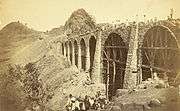 Photograph (1855) showing the construction of the Bhor Ghaut incline bridge, Bombay; the incline was conceived by George Clark, the Chief Engineer in the East India Company's Government of Bombay.
Photograph (1855) showing the construction of the Bhor Ghaut incline bridge, Bombay; the incline was conceived by George Clark, the Chief Engineer in the East India Company's Government of Bombay. Photograph (1858) of the Dapoorie viaduct over the Mula River near Poona in Bombay Presidency.[93]
Photograph (1858) of the Dapoorie viaduct over the Mula River near Poona in Bombay Presidency.[93]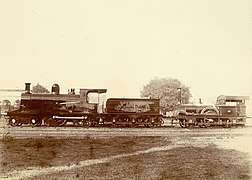 Photograph (1897) of the first locomotive, shown on the right and christened "multum in parvo" (barely visible on the wheel casing), which was used by the East Indian Railway Company in 1854 on its 23-mile line from Howrah to Pandua.
Photograph (1897) of the first locomotive, shown on the right and christened "multum in parvo" (barely visible on the wheel casing), which was used by the East Indian Railway Company in 1854 on its 23-mile line from Howrah to Pandua.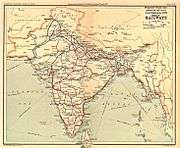 The trunk lines proposed by the Governor-General of India, Lord Dalhousie in his Railway minute of 1853 (shown in red on a 1908 railway map of India).
The trunk lines proposed by the Governor-General of India, Lord Dalhousie in his Railway minute of 1853 (shown in red on a 1908 railway map of India).
Canals
The first irrigation works undertaken during East India Company's rule were begun in 1817. Consisting chiefly of extensions or reinforcements of previous Indian works, these projects were limited to the plains north of Delhi and to the river deltas of the Madras Presidency.[94] A small dam in the Kaveri river delta, built some 1,500 years before, and known as the Grand Anicut, was one such indigenous work in South India. In 1835–36, Sir Arthur Cotton successfully reinforced the dam, and his success prompted more irrigation projects on the river. A little farther north, on the Tungabhadra river, the 16th century Vijayanagara ruler, Krishna Deva Raya, had constructed several weirs; these too would be extended under British administration.
In plains above Delhi, the mid-14th century Sultan of Delhi, Firoz Shah Tughlaq, had constructed the 150-mile long Western Jamna Canal. Taking off from the right bank of the Jamna river early in its course, the canal irrigated the Sultan's territories in the Hissar region of Eastern Punjab. By the mid-16th century, however, the fine sediment carried by the Himalayan river had gradually choked the canal. Desilted and reopened several decades later by Akbar the Great, the Western Jamna Canal was itself tapped by Akbar's grandson Shah Jahan, and some of its water was diverted to Delhi. During this time another canal was cut off the river. The 129-mile Eastern Jamna Canal or Doab Canal, which took off from the left bank of the Jamna, also high in its course, presented a qualitatively different difficulty. Since it was cut through steeply sloped land, its flow became difficult to control, and it was never to function efficiently. With the decline of Mughal Empire power in the 18th century, both canals fell into disrepair and closed. The Western Jamna Canal was repaired by British army engineers and it reopened in 1820. The Doab Canal was reopened in 1830; its considerable renovation involved raising the embankment by an average height of 9 ft. for some 40 miles.
Farther west in the Punjab region, the 130-mile long Hasli Canal, had been constructed by previous rulers. Taking off from the Ravi river and supplying water to the cities of Lahore and Amritsar, this left-bank canal was extended by the British in the Bari Doab Canal works during 1850–1857. The Punjab region, moreover, had much rudimentary irrigation by "inundation canals". Consisting of open cuts on the side of a river and involving no regulation, the inundation canals had been used in both the Punjab and Sindh for many centuries. The energetic administrations of the Sikh and Pathan governors of Mughal West Punjab had ensured that many such canals in Multan, Dera Ghazi Khan, and Muzaffargarh were still working efficiently at the time of the British annexation of the Punjab in 1849–1856 (period of tenure of the Marquess of Dalhousie Governor General).
The first new British work—with no Indian antecedents—was the Ganges Canal built between 1842 and 1854.[95] Contemplated first by Col. John Russell Colvin in 1836, it did not at first elicit much enthusiasm from its eventual architect Sir Proby Thomas Cautley, who balked at idea of cutting a canal through extensive low-lying land in order to reach the drier upland destination. However, after the Agra famine of 1837–38, during which the East India Company's administration spent Rs. 2,300,000 on famine relief, the idea of a canal became more attractive to the Company's budget-conscious Court of Directors. In 1839, the Governor General of India, Lord Auckland, with the Court's assent, granted funds to Cautley for a full survey of the swath of land that underlay and fringed the projected course of the canal. The Court of Directors, moreover, considerably enlarged the scope of the projected canal, which, in consequence of the severity and geographical extent of the famine, they now deemed to be the entire Doab region.
The enthusiasm, however, proved to be short lived. Auckland's successor as Governor General, Lord Ellenborough, appeared less receptive to large-scale public works, and for the duration of his tenure, withheld major funds for the project. Only in 1844, when a new Governor-General, Lord Hardinge, was appointed, did official enthusiasm and funds return to the Ganges canal project. Although the intervening impasse, had seemingly affected Cautely's health and required him to return to Britain in 1845 for recuperation, his European sojourn gave him an opportunity to study contemporary hydraulic works in Great Britain and Italy. By the time of his return to India even more supportive men were at the helm, both in the North-Western Provinces, with James Thomason as Lt. Governor, and in British India with Lord Dalhousie as Governor-General. Canal construction, under Cautley's supervision, now went into full swing. A 350-mile long canal, with another 300 miles of branch lines, eventually stretched between the headworks in Hardwar and—after splitting into two branches at Nanau near Aligarh—the confluence with the Ganges at Cawnpore (now Kanpur) and with the Jumna (now Yamuna) mainstem at Etawah. The Ganges Canal, which required a total capital outlay of £2.15 million, was officially opened in 1854 by Lord Dalhousie. According to historian Ian Stone:
It was the largest canal ever attempted in the world, five times greater in its length than all the main irrigation lines of Lombardy and Egypt put together, and longer by a third than even the largest USA navigation canal, the Pennsylvania Canal.
 Watercolor (1863) titled "The Ganges Canal, Roorkee, Saharanpur District (U.P.)". The canal was the brainchild of Sir Proby Cautley; construction began in 1840, and the canal was opened by Governor-General Lord Dalhousie in April 1854
Watercolor (1863) titled "The Ganges Canal, Roorkee, Saharanpur District (U.P.)". The canal was the brainchild of Sir Proby Cautley; construction began in 1840, and the canal was opened by Governor-General Lord Dalhousie in April 1854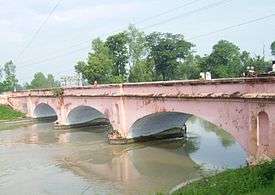 Photograph (2008) of an East India Company-era (1854) bridge on the Ganges Canal near Roorkee, Uttar Pradesh, India.
Photograph (2008) of an East India Company-era (1854) bridge on the Ganges Canal near Roorkee, Uttar Pradesh, India. Photograph (1860) of the head works of the Ganges Canal in Haridwar taken by Samuel Bourne
Photograph (1860) of the head works of the Ganges Canal in Haridwar taken by Samuel Bourne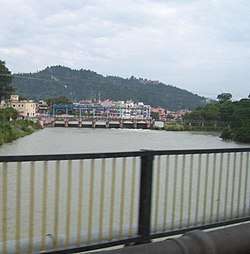 Photograph (2008) of the head works of the Ganges Canal in Haridwar, viewed from the opposite side.
Photograph (2008) of the head works of the Ganges Canal in Haridwar, viewed from the opposite side.
See also
Notes
- John Barnhill (14 May 2014). R. W. McColl (ed.). Encyclopedia of World Geography. Infobase Publishing. p. 115. ISBN 978-0-8160-7229-3.
- Robb 2002, pp. 116–147 "Chapter 5: Early Modern India II: Company Raj", Metcalf & Metcalf 2006, pp. 56–91 "Chapter 3: The East India Company Raj, 1772–1850", Bose & Jalal 2004, pp. 76–87 "Chapter 7: Company Raj and Indian Society 1757 to 1857, Reinvention and Reform of Tradition".
- Oxford English Dictionary, 2nd edition, 1989: Hindi, rāj, from Skr. rāj: to reign, rule; cognate with L. rēx, rēg-is, OIr. rī, rīg king (see RICH).
- Bose & Jalal 2004, p. 47
- Brown 1994, p. 46, Peers 2006, p. 30
- Metcalf & Metcalf 2006, p. 56
- "Maratha Wars". Encyclopedia Britannica. Encyclopedia Britannica.
- J. Albert Rorabacher (2016). Property, Land, Revenue, and Policy: The East India Company, C.1757–1825. Taylor & Francis. p. 236. ISBN 9781351997348.
- Tristram Hunt (2014). Cities of Empire: The British Colonies and the Creation of the Urban World. Henry Holt. p. 208. ISBN 9780805096002.
- Markovits 2004, pp. 271–
- Ludden 2002, p. 133
- Brown 1994, p. 67
- Brown 1994, p. 68
- Wickwire, p. 19
- Imperial Gazetteer of India vol. IV 1909, p. 9
- Imperial Gazetteer of India vol. IV 1909, p. 10
- "Orders of Battle – Orders of Battle". Archived from the original on 4 March 2016. Retrieved 27 December 2015.
- Imperial Gazetteer of India vol. IV 1909, p. 11
- "British East India Company captures Aden". Wolfram Alpha.
- "Official, India". World Digital Library. 1890–1923. Retrieved 30 May 2013.
- Bandyopadhyay 2004, p. 76, Imperial Gazetteer of India vol. IV 1909, p. 14
- Imperial Gazetteer of India vol. IV 1909, p. 14, Peers 2006, p. 35, Bandyopadhyay 2004, p. 76
- Peers 2006, p. 35
- Marshall 2007, p. 207
- Imperial Gazetteer of India vol. IV 1909, p. 14
- Marshall 2007, p. 197
- Bandyopadhyay 2004, p. 77
- Imperial Gazetteer of India vol. IV 1909, p. 14, Bandyopadhyay 2004, p. 77
- "in Council", i.e. in concert with the advice of the Council.
- Travers 2007, p. 211
- Quoted in Travers 2007, p. 213
- Guha 1995, p. 161
- Bandyopadhyay 2004, p. 78
- Imperial Gazetteer of India vol. IV 1909, p. 15
- Travers 2007, p. 213
- Peers 2006, p. 36
- Peers 2006, pp. 36–37
- Ludden 2002, p. 134
- Metcalf & Metcalf 2006, p. 20
- Metcalf & Metcalf 2006, p. 78
- Peers 2006, p. 47, Metcalf & Metcalf 2006, p. 78
- Peers 2006, p. 47
- Robb 2002, pp. 126–129
- Brown 1994, p. 55
- Peers 2006, pp. 45–47
- Peers 2006, pp. 45–47, Robb 2002, pp. 126–129
- Bandyopadhyay 2004, p. 82
- Marshall 1987, pp. 141–144
- Robb 2002, p. 127
- Guha 1995
- Bose 1993
- Tomlinson 1993, p. 43
- Metcalf & Metcalf 2006, p. 79
- Roy, Tirthankar (2000). The Economic History of India, 1857-1947 (1st ed.). Oxford University Press. pp. 37–42. ISBN 978-0-19-565154-6.
- Brown 1994, p. 66
- Robb 2002, p. 128
- Peers 2006, p. 47, Brown 1994, p. 65
- Bayly 1987, pp. 84–86
- Metcalf & Metcalf 2006, p. 61
- Imperial Gazetteer of India vol. IV 1909, p. 333
- Metcalf & Metcalf 2006, p. 61, Bayly 1987, pp. 84–86
- Imperial Gazetteer of India vol. IV 1909, p. 335
- Imperial Gazetteer of India vol. IV 1909, p. 337
- Imperial Gazetteer of India vol. IV 1909, p. 338
- Brown 1994, p. 88
- Bandyopadhyay 2004, p. 171, Bose & Jalal 2004, pp. 70–71
- Puri, B. N. (1967). "The Training of Civil Servants under the Company". Journal of Indian History. 45 (135): 749–771.
- David Gilmour, The Ruling Caste: Imperial Lives in the Victorian Raj (2005)
- Colin Newbury, "Patronage and Professionalism: Manning a Transitional Empire, 1760–1870". Journal of Imperial and Commonwealth History (2013) 42#2 pp: 193–213.
- Philip Lawson (2014). The East India Company: A History. Routledge. pp. 149–54. ISBN 9781317897651.
- Robb 2002, pp. 131–134
- Sashi Sivramkrishna (13 September 2016). In Search of Stability: Economics of Money, History of the Rupee. Taylor & Francis. pp. 91–. ISBN 978-1-351-99749-2.
- Peers 2006, pp. 48–49
- Farnie 1979, p. 33
- Misra 1999, p. 18
- Peers 2006, p. 49
- Washbrook 2001, p. 403
- Metcalf & Metcalf 2006, p. 76
- Bose & Jalal 2004, p. 57
- Bandyopadhyay 2004, p. 125
- Bandyopadhyay 2004, p. 125, Bose & Jalal 2004, p. 57
- Robb 2002, p. 137
- Imperial Gazetteer of India vol. IV 1909, p. 413
- Imperial Gazetteer of India vol. IV 1909, p. 414
- Stokes 1986, Brown 1994, p. 91
- Majumdar, Mohini Lal. The imperial post offices of British India, 1837–1914 (Phila Publications, 1990)
- Headrick, Daniel (2010). "A double-edged sword: Communications and imperial control in British India". Historical Social Research/Historische Sozialforschung. 35 (1): 51–65. JSTOR 20762428.
- Rahman, Siddique Mahmudur (2002). "Postal Services During The East India Company's Rule In Bengal". Bangladesh Historical Studies. 19: 43.
- Gorman, Mel (October 1971). "Sir William O'Shaughnessy, Lord Dalhousie, and the Establishment of the Telegraph System in India". Technology and Culture. 12 (4): 581–601. doi:10.2307/3102572. JSTOR 3102572.
- Stockton and Darlington Railway
- Macpherson, W. J. (1955). "Investment in Indian railways, 1845–1875". Economic History Review. 8 (2): 177–186. doi:10.1111/j.1468-0289.1955.tb01558.x.
- Thorner, Daniel. "Great Britain and the development of India's railways". Journal of Economic History 1951; 11(4): 389–402. online
- Chatterjee, Arup (2019), The Great Indian Railways: A Cultural Biography, Bloomsbury Publishing, pp. 318–, ISBN 978-93-88414-23-4
- Stone 2002, p. 13
- Stone 2002, p. 16
References
General histories
- Bandyopadhyay, Sekhara (2004). From Plassey to Partition: A History of Modern India. New Delhi: Orient Longman. ISBN 978-81-250-2596-2.
- Bayly, C. A. (1987). Indian Society and the Making of the British Empire. The New Cambridge History of India. II.1. Cambridge University Press. ISBN 978-0-521-38650-0..
- Bayly, C.A. The Raj: India and the British 1600-1947 (1990)
- Bose, Sugata; Jalal, Ayesha (2004) [First published 1998]. Modern South Asia: History, Culture, Political Economy (2nd ed.). London: Routledge. ISBN 978-0-415-30787-1.
- Brown, Judith Margaret (1994), Modern India: the origins of an Asian democracy, Oxford University Press, ISBN 978-0-19-873112-2
- Judd, Denis (2010), The lion and the tiger: the rise and fall of the British Raj, 1600-1947, Oxford University Press, ISBN 978-0-19-280579-9
- Kulke, Hermann; Rothermund, Dietmar (2004), A history of India, Routledge, ISBN 978-0-415-32920-0
- Lawson, Philip. The East India Company: A History (Routledge, 1993) excerpt and text search
- Ludden, David (2002), India and South Asia: a short history, Oneworld, ISBN 978-1-85168-237-9
- Markovits, Claude (2004), A history of modern India, 1480-1950, Anthem Press, ISBN 978-1-84331-152-2, retrieved 5 November 2011
- Metcalf, Barbara Daly; Metcalf, Thomas R. (2006), A concise history of modern India, Cambridge University Press, ISBN 978-0-521-86362-9
- Peers, Douglas M. (2006), India under colonial rule: 1700-1885, Pearson Education, ISBN 978-0-582-31738-3
- Moon, Penderel. The British conquest and dominion of India (2 vol. India Research Press, 1989)
- Riddick, John F. The history of British India: a chronology (2006) excerpt and text search, covers 1599–1947
- Riddick, John F. Who Was Who in British India (1998), covers 1599–1947
- Robb, Peter (2002). A History of India (1st ed.). Palgrave Macmillan. ISBN 978-0-333-69129-8.
- Robb, Peter (2011) [First published 2002]. A History of India (2nd ed.). Palgrave Macmillan. ISBN 978-0-230-34549-2.
- Spear, Percival (1990) [First published 1965], A History of India, Volume 2, Penguin Books, ISBN 978-0-14-013836-8
- Stein, Burton; Arnold, David (2010), A History of India, John Wiley and Sons, ISBN 978-1-4051-9509-6
- Wolpert, Stanley (2008), A new history of India, Oxford University Press, ISBN 978-0-19-533756-3
Monographs and collections
- Ambirajan, S. (2007) [1978], Classical Political Economy and British Policy in India, Cambridge University Press, ISBN 978-0-521-05282-5, retrieved 20 February 2012
- Anderson, Clare (2007), The Indian Uprising of 1857-8: prisons, prisoners, and rebellion, Anthem Press, ISBN 978-1-84331-295-6, retrieved 5 November 2011
- Bayly, C. A. (2000), Empire and Information: Intelligence Gathering and Social Communication in India, 1780–1870 (Cambridge Studies in Indian History and Society), Cambridge and London: Cambridge University Press. Pp. 426, ISBN 978-0-521-66360-1
- Chakrabarti, D.K. 2003. The Archaeology of European Expansion in India, Gujarat, c. 16th–18th Centuries (2003) Delhi: Aryan Books International
- Chaudhuri, Kirti N. The Trading World of Asia and the English East India Company: 1660-1760 (Cambridge University Press, 1978)
- Bose, Sumit (1993), Peasant Labour and Colonial Capital: Rural Bengal since 1770 (New Cambridge History of India), Cambridge and London: Cambridge University Press..
- Chandavarkar, Rajnarayan (1998), Imperial Power and Popular Politics: Class, Resistance and the State in India, 1850–1950, (Cambridge Studies in Indian History & Society). Cambridge and London: Cambridge University Press. Pp. 400, ISBN 978-0-521-59692-3.
- Das, Amita; Das, Aditya. Defending British India against Napoleon: The Foreign Policy of Governor-General Lord Minto, 1807-13 ( Rochester: Boydell Press, 2016) ISBN 978-1-78327-129-0. online review
- Erikson, Emily. Between Monopoly and Free Trade: The English East India Company, 1600-1757 (Princeton University Press, 2014)
- Farnie, D. A. (1979), The English Cotton Industry and the World Market, 1815–1896, Oxford, UK: Oxford University Press. Pp. 414, ISBN 978-0-19-822478-5
- Gilmour, David. The Ruling Caste: Imperial Lives in the Victorian Raj (New York: Farrar, Straus and Giroux, 2005).
- Guha, R. (1995), A Rule of Property for Bengal: An Essay on the Idea of the Permanent Settlement, Durham, NC: Duke University Press, ISBN 978-0-521-59692-3.
- Hossain, Hameeda. The Company weavers of Bengal: the East India Company and the organization of textile production in Bengal, 1750-1813 (Oxford University Press, 1988)
- Marshall, P. J. (1987), Bengal: The British Bridgehead, Eastern India, 1740–1828, Cambridge and London: Cambridge University Press
- Marshall, P. J. (2007), The Making and Unmaking of Empires: Britain, India, and America c.1750–1783, Oxford and New York: Oxford University Press. Pp. 400, ISBN 978-0-19-922666-5
- Metcalf, Thomas R. (1991), The Aftermath of Revolt: India, 1857–1870, Riverdale Co. Pub. Pp. 352, ISBN 978-81-85054-99-5
- Metcalf, Thomas R. (1997), Ideologies of the Raj, Cambridge and London: Cambridge University Press, Pp. 256, ISBN 978-0-521-58937-6
- Misra, Maria (1999), Business, Race, and Politics in British India, c.1850–1860, Delhi: Oxford University Press. Pp. 264, ISBN 978-0-19-820711-5
- Porter, Andrew, ed. (2001), Oxford History of the British Empire: Nineteenth Century, Oxford and New York: Oxford University Press. Pp. 800, ISBN 978-0-19-924678-6
- Roy, Tirthankar (2011) [First published 2000], Economic History of India, 1857-1947 (3rd ed.), Oxford University Press, ISBN 978-0-19-807417-5, retrieved 19 February 2012
- Stokes, Eric (1986), Bayly, C.A. (ed.), The Peasant Armed: The Indian Revolt of 1857, Oxford: Clarendon Press, p. 280, ISBN 978-0-19-821570-7.
- Stone, Ian (2002), Canal Irrigation in British India: Perspectives on Technological Change in a Peasant Economy (Cambridge South Asian Studies), Cambridge and London: Cambridge University Press. Pp. 392, ISBN 978-0-521-52663-0
- Tomlinson, B. R. (1993), The Economy of Modern India, 1860–1970 (The New Cambridge History of India, III.3), Cambridge and London: Cambridge University Press..
- Travers, Robert (2007), Ideology and Empire in Eighteenth Century India: The British in Bengal (Cambridge Studies in Indian History and Society), Cambridge and London: Cambridge University Press. Pp. 292, ISBN 978-0-521-05003-6
Articles in journals or collections
- Banthia, Jayant; Dyson, Tim (December 1999), "Smallpox in Nineteenth-Century India", Population and Development Review, 25 (4): 649–689, doi:10.1111/j.1728-4457.1999.00649.x, JSTOR 172481, PMID 22053410
- Broadberry, Stephen; Gupta, Bishnupriya (2009), "Lancashire, India, and shifting competitive advantage in cotton textiles, 1700–1850: the neglected role of factor prices", Economic History Review, 62 (2): 279–305, doi:10.1111/j.1468-0289.2008.00438.x
- Caldwell, John C. (December 1998), "Malthus and the Less Developed World: The Pivotal Role of India", Population and Development Review, 24 (4): 675–696, doi:10.2307/2808021, JSTOR 2808021
- Clingingsmith, David; Williamson, Jeffrey G. (2008), "Deindustrialization in 18th and 19th century India: Mughal decline, climate shocks and British industrial ascent", Explorations in Economic History, 45 (3): 209–234, doi:10.1016/j.eeh.2007.11.002
- Drayton, Richard (2001), "Science, Medicine, and the British Empire", in Winks, Robin (ed.), Oxford History of the British Empire: Historiography, Oxford and New York: Oxford University Press, pp. 264–276, ISBN 978-0-19-924680-9
- Frykenberg, Robert E. (2001), "India to 1858", in Winks, Robin (ed.), Oxford History of the British Empire: Historiography, Oxford and New York: Oxford University Press, pp. 194–213, ISBN 978-0-19-924680-9
- Harnetty, Peter (July 1991), "'Deindustrialization' Revisited: The Handloom Weavers of the Central Provinces of India, c. 1800-1947", Modern Asian Studies, 25 (3): 455–510, doi:10.1017/S0026749X00013901, JSTOR 312614
- Heuman, Gad (2001), "Slavery, the Slave Trade, and Abolition", in Winks, Robin (ed.), Oxford History of the British Empire: Historiography, Oxford and New York: Oxford University Press, pp. 315–326, ISBN 978-0-19-924680-9
- Klein, Ira (1988), "Plague, Policy and Popular Unrest in British India", Modern Asian Studies, 22 (4): 723–755, doi:10.1017/S0026749X00015729, JSTOR 312523, PMID 11617732
- Klein, Ira (July 2000), "Materialism, Mutiny and Modernisation in British India", Modern Asian Studies, 34 (3): 545–580, doi:10.1017/S0026749X00003656, JSTOR 313141
- Kubicek, Robert (2001), "British Expansion, Empire, and Technological Change", in Porter, Andrew (ed.), Oxford History of the British Empire: The Nineteenth Century, Oxford and New York: Oxford University Press, pp. 247–269, ISBN 978-0-19-924678-6
- Raj, Kapil (2000), "Colonial Encounters and the Forging of New Knowledge and National Identities: Great Britain and India, 1760–1850", Osiris, 2nd Series, 15 (Nature and Empire: Science and the Colonial Enterprise): 119–134, doi:10.1086/649322, JSTOR 301944
- Ray, Rajat Kanta (July 1995), "Asian Capital in the Age of European Domination: The Rise of the Bazaar, 1800–1914", Modern Asian Studies, 29 (3): 449–554, doi:10.1017/S0026749X00013986, JSTOR 312868
- Roy, Tirthankar (Summer 2002), "Economic History and Modern India: Redefining the Link", The Journal of Economic Perspectives, 16 (3): 109–130, doi:10.1257/089533002760278749, JSTOR 3216953
- Tomlinson, B. R. (2001), "Economics and Empire: The Periphery and the Imperial Economy", in Porter, Andrew (ed.), Oxford History of the British Empire: The Nineteenth Century, Oxford and New York: Oxford University Press, pp. 53–74, ISBN 978-0-19-924678-6
- Washbrook, D. A. (2001), "India, 1818–1860: The Two Faces of Colonialism", in Porter, Andrew (ed.), Oxford History of the British Empire: The Nineteenth Century, Oxford and New York: Oxford University Press, pp. 395–421, ISBN 978-0-19-924678-6
- Wylie, Diana (2001), "Disease, Diet, and Gender: Late Twentieth Century Perspectives on Empire", in Winks, Robin (ed.), Oxford History of the British Empire: Historiography, Oxford and New York: Oxford University Press, pp. 277–289, ISBN 978-0-19-924680-9
Classic histories and gazetteers
- Allan, J., and Sir T. Wolseley Haig. The Cambridge shorter history of India (edited by Henry Dodwell. 1934) pp 399–589
- The Imperial Gazetteer of India (PDF). Volume IV: The Indian Empire, Administrative. Oxford: Clarendon Press. 1909.
- Majumdar, R. C.; Raychaudhuri, H. C.; Datta, Kalikinkar (1950), An Advanced History of India, London: Macmillan and Company Limited. 2nd edition. Pp. xiii, 1122, 7 maps, 5 coloured maps.
- Wilson, Horace H (1845), The History of British India from 1805 to 1835, London: James Madden and Co., OCLC 63943320
- Smith, Vincent A. (1921), India in the British Period: Being Part III of the Oxford History of India, Oxford: At the Clarendon Press. 2nd edition. Pp. xxiv, 316 (469–784)
- Thompson, Edward, and G. T. Garratt. Rise and fulfilment of British rule in India (Macmillan and Company, 1934.) 699pp; from 1599 to 1933
- Unknown (1829), Historical and Ecclesiastical Sketches of Bengal; From the Earliest Settlement, Until the Virtual Conquest of that Country by the English, in 1757, Calcutta
- Bruce, John (1810), Annals of the Honorable East-India Company: from their establishment by the charter of queen Elizabeth, 1600 to the Union of the London and the English East India Companies 1707-8, Vol-I, Black, Parry, and Kingsbury
- Bruce, John (1810), Annals of the Honorable East-India Company: from their establishment by the charter of queen Elizabeth, 1600 to the Union of the London and the English East India Companies 1707-8, Vol-II, London, Black, Parry, and Kingsbury
- Marshman, John Clark (1867), The History of India From the Earliest Period to the Close of Lord Dalhousie's Administration – 1867, Vol-I, Longmans, Green

- India from Congress
- Pakistan from Congress
| Wikiquote has quotations related to: Company rule in India |
.svg.png)

